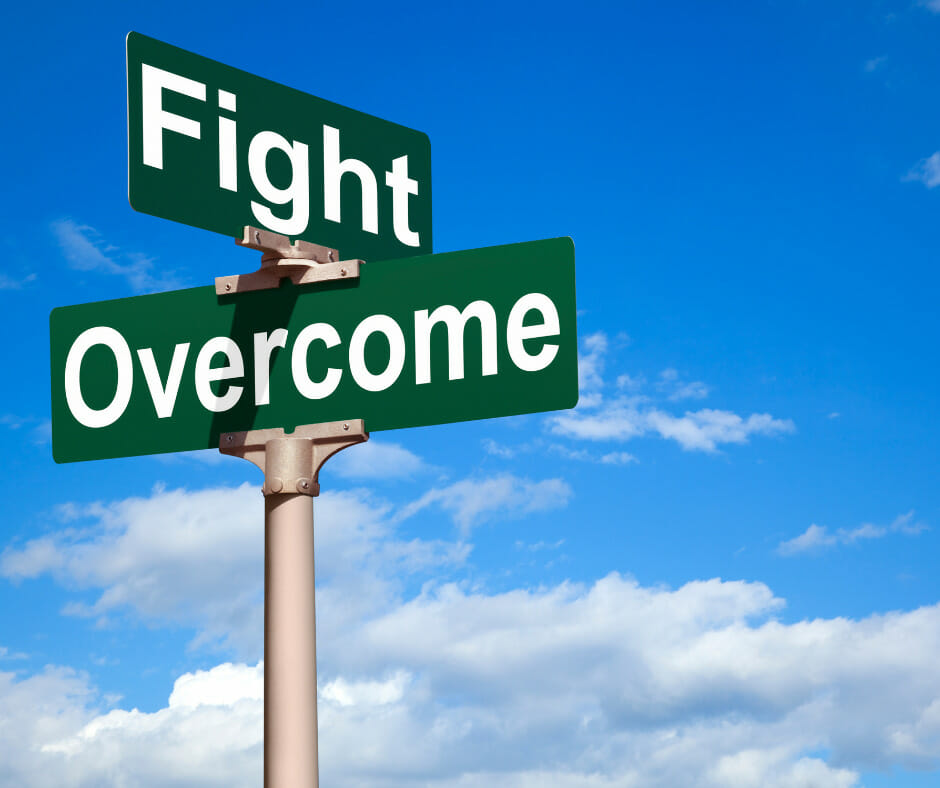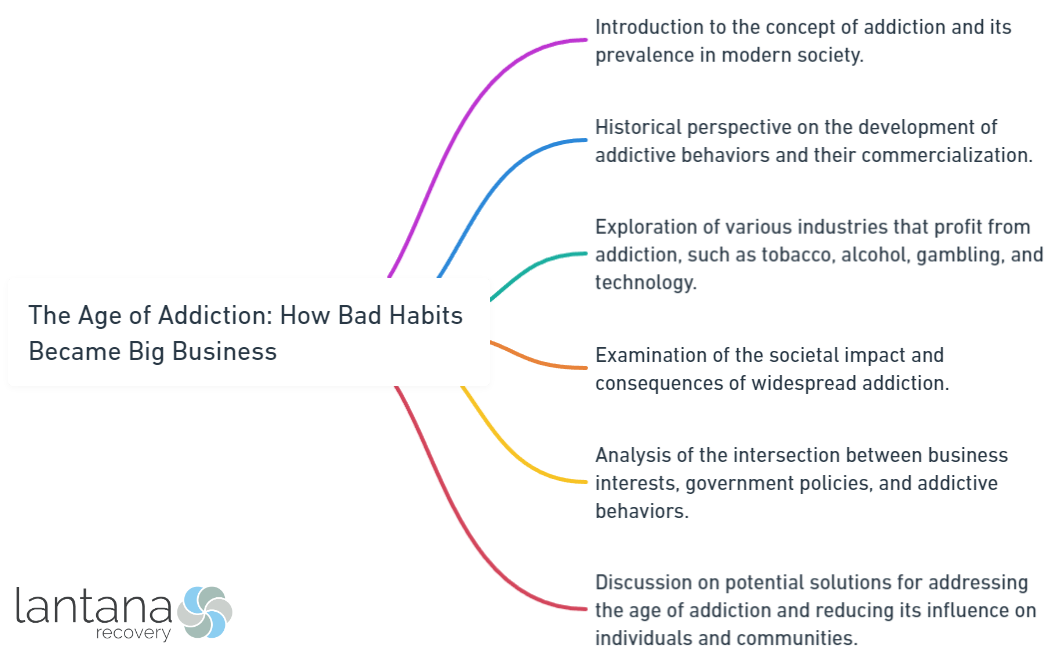“The Age of Addiction: How Bad Habits Became Big Business” is a thought-provoking book that delves into the complex interplay between addiction and the modern world. Authored by renowned writer and researcher, David Courtwright, the book provides an overview of its core themes and sets the stage for a deeper exploration of addiction. It examines the concept of addiction in the modern age, offering insights into its definition and how it has evolved over time.
One of the key focuses of the book is the business aspect of addiction. It delves into the rise of industries built around addiction, uncovering the role of advertising, marketing, and technology in fueling addictive behaviors.
Furthermore, the book explores the profound impact of addiction on individuals and society as a whole. It delves into how addiction affects mental and physical health, as well as the social and economic consequences it brings.
However, “The Age of Addiction” doesn’t just highlight the problem; it also provides hope and solutions. It offers effective strategies for addiction recovery and discusses the importance of prevention and reducing addiction at a societal level.
About the Book: “The Age of Addiction: How Bad Habits Became Big Business”
“The Age of Addiction: How Bad Habits Became Big Business” sheds light on the factors that have contributed to the rise of addiction as a lucrative industry and offers provocative ideas that could appeal to both readers of this journal and the wider community according to Peter G Brindley, MD’s review. Courtwright presents a compelling argument about addiction as a profitable industry, with companies exploiting vulnerabilities for financial gain. Through careful analysis, the book examines the development of addictive products and the manipulation of consumer behavior, shedding light on the consequences for individuals and society.
Courtwright goes on to analyze how addiction, such as smoking, gambling, and technology addiction, has become deeply entrenched in our culture. This is perpetuated by the powerful industries that profit from it. The author uncovers the tactics used by companies to exploit human psychology and create demand for addictive products.
Additionally, the book thoroughly explores the role of advertising, marketing strategies, and the influence of social media in perpetuating addictive behaviors. Courtwright supports their arguments with extensive research and illuminating examples, making “The Age of Addiction: How Bad Habits Became Big Business” both informative and enlightening.
By reading this book, readers gain a deep understanding of the interplay between personal choices, industry influence, and societal factors in addiction. Courtwright highlights the urgent need for awareness and regulation to mitigate the harmful effects of addiction on individuals and society.
“The Age of Addiction: How Bad Habits Became Big Business” provides invaluable insights into the mechanisms that allow addictive behaviors to thrive in our modern world. It is a must-read for those interested in understanding the societal, economic, and psychological forces behind addiction.

Exploring the Concept of Addiction
Addiction – a concept deeply rooted in the fabric of our modern society, its impact cannot be understated. In this section, we delve into the multifaceted nature of addiction, examining its definition in the contemporary era and tracing its evolution over time. Brace yourself for a journey that uncovers the intricate complexities and implications of addiction, shedding light on why it has become one of the most pressing issues of our age.
Defining Addiction in the Modern Age
Addiction in the modern age is defined as a chronic brain disorder marked by compulsive drug seeking and use, despite the negative effects it causes. This includes not only substance abuse, but also behavioral addictions like gambling, gaming, and excessive internet use. Several factors contribute to addiction, including genetics and changes in brain chemistry. Additionally, environmental factors such as social influences and exposure to addictive substances or behaviors also play a significant role.
When the addictive substance or behavior is stopped, withdrawal symptoms can occur. The treatment for addiction involves a comprehensive approach that incorporates evidence-based therapies, medications, and support programs. If you or someone you know is struggling with addiction, it is crucial to seek professional help and support for a successful recovery. It’s important to remember that addiction can be treated.
Understanding the Evolution of Addiction
Understanding the evolution of addiction is crucial in comprehending its prevalence in modern society. Addiction has evolved over time, changing its definition and understanding. In the past, addiction was associated with substance abuse like alcohol or drugs. However, our understanding has expanded to include behaviors such as gambling, gaming, and social media.
Research has shown that addiction is not solely due to personal weakness. It is influenced by genetic, psychological, social, and environmental factors. In the 2012 study titled Meta-Analysis of Individual and Environmental Factors that Influence People’s Addiction Tendencies by Saideh Safari Hajat Aghaii et al., addiction is a multifaceted disease with biological, psychological, and social aspects that impact over 15% of the adult population in America who are 18 years of age or older. One is the advancement of technology, making addictive substances and activities more accessible. The internet has led to the creation of online gambling and social media platforms, increasing the risk of addiction.
Advertising and marketing also play a significant role. Companies target vulnerable individuals using persuasive techniques to promote addictive products or behaviors. Understanding the evolution of addiction is essential in addressing and combating this issue. By recognizing contributing factors and implementing effective prevention strategies, we can minimize the negative impact on individuals and society.

The Business of Addiction
In a world where addiction has become big business, we delve into the captivating section that uncovers the dark underbelly of “The Business of Addiction.” Brace yourself as we explore the rise of industries built on addiction, the insidious role of advertising and marketing, and the powerful influence of technology. Prepare to be shocked, intrigued, and enlightened as we uncover the gripping realities behind this pervasive phenomenon.
The Rise of Industries Built on Addiction
The rise of addiction-driven industries, such as gambling, tobacco, pharmaceuticals, and alcohol, has had a significant impact on the economy and individuals. These industries exploit human vulnerabilities to create profitable businesses that capitalize on addictive behaviors.
The gambling industry, including both gambling establishments and online platforms, has seen a tremendous rise in popularity. They specifically target individuals susceptible to developing addictive behaviors by leveraging the thrill and excitement associated with gambling. These industries generate substantial revenue, with billions of dollars spent each year.
Despite growing awareness of smoking’s health risks, the tobacco industry continues to thrive. Cigarette manufacturers employ marketing strategies that specifically target vulnerable populations, such as teenagers and young adults. The addictive nature of nicotine contributes to the longevity of this industry.
The pharmaceutical industry has played a significant role in the rise of addiction. Prescription medications, particularly opioids, have been overprescribed, leading to a widespread opioid epidemic. Pharmaceutical companies profit greatly from the sale of these addictive drugs.
The alcohol industry has also contributed to the rise of addiction. While alcohol has long been part of social activities and celebrations, alcohol companies’ marketing and advertising tactics often promote excessive drinking and glamourize alcohol as a necessary component of a fun and fulfilling lifestyle.
The rise of addiction-driven industries has devastating consequences for individuals and society as a whole. Recognizing the manipulative tactics employed by these industries is crucial. Proactive measures, such as education, awareness, and support systems, are vital in addressing addiction effectively.
By being mindful of the harmful impact of addiction-driven industries, individuals can make informed choices and seek help when needed. Governments and regulatory bodies must implement stricter policies and regulations to curb the unethical practices of these industries. Together, society can work towards reducing the influence of addiction on people’s lives and fostering a healthier and more balanced society.
The Role of Advertising and Marketing in Addiction
The role of advertising and marketing in addiction is of utmost significance. It actively promotes and perpetuates addictive behaviors, which is a matter of concern. Here are some key points that shed light on this issue:
1. Targeted marketing: Advertisers and marketers specifically aim at vulnerable populations, such as youth and individuals with pre-existing addictive tendencies. This deliberate targeting increases the likelihood of addiction. For more information, please refer to The Age of Addiction: How Bad Habits Became Big Business.
2. Psychological manipulation: Techniques used in advertising exploit human vulnerabilities and desires. Emotional appeals and meticulously crafted messages are employed to create a strong desire for addictive substances or behaviors.
3. Normalization of addiction: Advertising and marketing campaigns glamorize addictive substances or behaviors, thereby presenting addiction as acceptable or even desirable.
4. Creating brand loyalty: Advertising and marketing efforts strengthen the connection between certain products or behaviors and pleasure or reward by using branding and repetitive exposure. This leads to the development of brand loyalty and ultimately addictive consumption.
5. Influence on cultural norms: Advertising and marketing have the power to shape societal perceptions and values regarding addiction. They play a crucial role in determining what is socially acceptable or desirable in relation to addiction.
Throughout history, advertising and marketing have experienced a growing level of influence. From traditional print advertisements to more targeted digital marketing strategies, the techniques for promoting addictive substances and behaviors have evolved. Numerous studies have demonstrated that advertising and marketing exert a significant impact on individuals who are vulnerable to addiction, resulting in harmful habits and detrimental consequences for both individuals and society as a whole. In order to prioritize the well-being of individuals above corporate interests, it is essential to develop regulations and ethical standards as our understanding of the role of advertising and marketing in addiction continues to expand.
The Influence of Technology on Addiction
The impact of technology on addiction is substantial in the modern era. Technology has seamlessly integrated into everyday life and has played a pivotal role in the proliferation of addiction in diverse ways.
One notable way that technology impacts addiction is through the increased accessibility of addictive substances and behaviors. Through smartphones and the internet, individuals can effortlessly access online gambling platforms, social media, and other addictive activities. This heightened accessibility has resulted in a greater prevalence of addiction to these technologies.
Furthermore, technology has given rise to new forms of addiction, such as internet addiction and gaming addiction. These types of addictions are characterized by excessive and compulsive use of technology, which consequently has detrimental effects on mental and physical health.
Moreover, technology has actively contributed to the development and spread of addictive behaviors. Social media platforms, for instance, utilize algorithms and targeted advertising to keep users engaged and addicted. Consequently, this has led to addictive patterns of behavior, including excessive scrolling on social media and seeking validation through likes and comments.
Recognizing the influence of technology on addiction is of utmost importance, and proactive measures should be taken to address and prevent it. This can involve implementing boundaries on technology usage, promoting digital well-being, and providing education and support for individuals grappling with technology addiction.

The Impact on Individuals and Society
Addiction is more than just a personal struggle; its impact reverberates through individuals and society as a whole. In this section, we dive into the profound influence addiction has on our mental and physical well-being. We also explore the far-reaching consequences addiction imposes on our social fabric and economic stability. Brace yourself for eye-opening insights as we navigate the intricate web of addiction and its detrimental effects on individuals and society.
How Addiction Affects Mental and Physical Health
Understanding how addiction affects mental and physical health is crucial. Addiction significantly impacts mental health, worsening anxiety, depression, and bipolar disorder. Substance abuse alters brain chemistry and impairs cognitive functions, such as memory, concentration, and decision-making. Addiction also leads to social isolation, strained relationships, and a decline in overall well-being.
Additionally, addiction takes a toll on physical health. Substance abuse causes various health problems depending on the substance involved. For example, smoking leads to respiratory issues, heart disease, and lung cancer. Alcohol abuse damages the liver and can result in liver cirrhosis. Illegal drug use can lead to organ damage, infectious diseases, and overdose.
It’s important to recognize that addiction and mental health issues often coexist. Many individuals struggling with addiction have underlying mental health disorders, and vice versa. These co-occurring disorders require integrated treatment approaches that address both aspects for successful recovery.
Seeking professional help is crucial in addressing addiction’s impact on mental and physical health. Treatment programs that provide a comprehensive approach, including therapy, counseling, and medical support, can help individuals manage their addiction and address the associated health issues. Support systems, such as support groups or individual therapy, also play a vital role in recovery and improving overall well-being.
Fact: According to the National Survey on Drug Use and Health, approximately 8.4 million adults in the United States had both a mental health disorder and a substance use disorder in 2019.
The Social and Economic Consequences of Addiction
The social and economic consequences of addiction are vast and significant. Addiction has the potential to strain relationships and result in social isolation, making it harder for individuals to connect with others.
Furthermore, addiction can have a negative impact on one’s ability to fulfill responsibilities and contribute to society. This can lead to job loss, financial instability, and decreased productivity, all of which can hinder an individual’s overall well-being.
Moreover, addiction can also push individuals towards criminal behavior, which can lead to their incarceration. This not only affects the individuals involved but also has broader implications for society as a whole.
| From an economic perspective, addiction places a heavy burden on healthcare systems. Treating addiction-related health issues can incur substantial costs, putting pressure on already strained resources. |
In addition, addiction can hinder economic growth and development. “The impaired functioning, greater morbidity, and early mortality experienced by those who misuse substances can collectively be defined as the disease burden of substance misuse, and can be quantified in terms of disability adjusted life years (DALYs), or the number of years of fully functional life lost” (Substance misuse prevention and economic analysis: Challenges and opportunities regarding international utility, Guyll et al., 2012.)
To address these consequences effectively, prevention, early intervention, and access to effective addiction treatment and support services are paramount. Establishing comprehensive support systems that acknowledge the multidimensional nature of addiction is crucial. These systems can provide individuals with the necessary tools and resources to recover from addiction and rebuild their lives.
By addressing both the social and economic consequences of addiction, we can build healthier communities. Furthermore, we can reduce the financial burdens associated with addiction and promote long-term recovery and well-being for individuals affected by addiction.

Overcoming Addiction and Breaking the Cycle
Breaking free from the grasp of addiction is an uphill battle, but it is not one that we face alone. In this section, we will dive into the methods that can help us overcome addiction and break the cycle of destructive behaviors. From effective strategies for addiction recovery to initiatives aimed at preventing and reducing addiction at a societal level, we will explore the tools and approaches that empower individuals and communities to triumph over addiction. Let’s embark on this journey toward liberation and healing together.
Effective Strategies for Addiction Recovery
Effective strategies for addiction recovery are crucial. Here are some strategies that can aid in the recovery process:
1. Consult addiction specialists, therapists, or counselors who can provide guidance and support throughout the recovery journey. They can offer personalized treatment plans and therapies.
2. Join support groups like Alcoholics Anonymous (AA) or Narcotics Anonymous (NA) to find community and encouragement. Interacting with others who have similar experiences can help individuals feel understood and motivated which is why educational programs like the Half of Us Addiction Initiative are incredible resources as well.
3. Create a relapse prevention plan. This involves identifying triggers, developing coping mechanisms, and building a support network to prevent relapse and maintain long-term recovery.
4. Engage in evidence-based therapies such as cognitive-behavioral therapy (CBT) and dialectical behavior therapy (DBT) to address the underlying causes of addiction and teach healthy coping strategies.
5. Adopt a healthy lifestyle including regular exercise, adequate sleep, balanced nutrition, and practicing stress management techniques like meditation or mindfulness. You can also get enjoy the therapeutic effects of nature in healthy amounts.
Implementing these effective strategies for addiction recovery can greatly enhance the chances of successful recovery. It is important to remember that recovery is a unique journey, and finding the strategies that work best for each individual is key.
Preventing and Reducing Addiction at a Societal Level
Prevention strategies can include:
-
Education and Awareness: It is important to promote comprehensive education programs that provide information about addiction risks and consequences. By raising awareness about the importance of making healthy choices and developing coping skills, we can empower individuals to make informed decisions.
-
Early Intervention: Implementing programs that identify and support individuals at risk of addiction is crucial. This can be achieved through counseling services, mentorship, professional help from Lantana Recovery, a Charleston Drug Rehab Center, and providing resources for resilience and healthy coping. By intervening early, we can prevent addiction from taking hold and provide the necessary support for individuals.
-
Access to Treatment: Ensuring that accessible and affordable treatment options are available for those struggling with addiction is essential. This can be achieved by increasing funding for rehabilitation centers, counseling services, and support groups. It is also important to address the stigma associated with addiction and create a safe environment for individuals seeking help.
-
Community Support: Building supportive networks within communities is vital for promoting healthy behaviors and providing alternatives to addictive substances or activities. Community engagement in recreational activities, sports, and cultural events can foster a sense of belonging and connectedness, reducing the likelihood of addiction.
-
Regulation and Policies: Implementing strict regulations on industries that profit from addictive substances or behaviors is crucial. This includes industries such as tobacco, alcohol, and gambling. By creating policies that restrict advertising and marketing targeting vulnerable populations, especially young individuals, we can prevent the spread of addiction.
By implementing these strategies, we can work towards preventing and reducing addiction, leading to healthier and more resilient communities. It is important to prioritize the well-being and prosperity of our society by proactively addressing addiction at a societal level.
Frequently Asked Questions
What is the book “The Age of Addiction” about?
“The Age of Addiction” explores the prevalence of addiction in modern society and the role that corporations play in shaping our habits and desires. It delves into topics such as addiction to opioids, food, digital media, and more.
What is limbic capitalism?
Limbic capitalism refers to the network of competitive businesses that target the brain pathways responsible for our feelings, motivations, and long-term memory. It capitalizes on our innate desire for new and pleasurable experiences, often leading to addiction.
What are examples of limbic capitalism in action?
Examples of limbic capitalism include Purdue Pharma’s pain pills, McDonald’s engineered burgers, and Tencent video games from China. These companies exploit our desires for pleasurable experiences, leading to addictive behaviors.
How has technology impacted addictive behaviors?
Technology has contributed to the emergence of new addictions, such as compulsive gaming and social media app addiction. In 2018, the World Health Organization recognized “gaming disorder” as a legitimate condition, highlighting the influence of technology on addictive behaviors.
What role do multinational industries play in addiction?
Multinational industries, with the assistance of complicit governments and criminal organizations, have proliferated and made addictive substances and activities more accessible and affordable. They contribute to the addictive culture by promoting and providing addictive products, including junk food and pornography.
How can we resist temptations and advocate for change?
Understanding the history and nature of addiction is crucial in resisting its allure. Organized opposition from various political factions, such as progressives, nationalists, and traditionalists, has historically united against the purveyors of addiction. By joining forces and advocating for change, we can work towards combating limbic capitalism and its detrimental effects.
What is the main message and call to action in “The Age of Addiction”?
The main message of “The Age of Addiction” is to raise awareness about addiction and the role of corporations in perpetuating addictive behaviors. The book serves as a call to action, urging readers to understand the history and nature of addiction, resist its temptations, and advocate for change in order to combat the influence of limbic capitalism.










